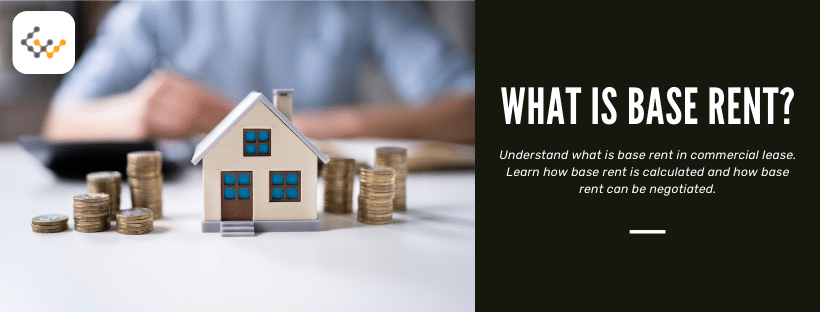What is Base Rent in Commercial Lease?

A base rent provision is often in place within a commercial lease in commercial real estate. Most often listed as a clause, this is an important component for property owners and renters to understand. It provides specific insight into the tenant’s rent obligation.
It is not uncommon for commercial property investors and owners to work through a rent negotiation process with prospective tenants. In that process, both parties must agree on various factors, including rental rates in general, as well as how much rent will increase year over year. In addition, there may be a free-rent period. These conversions are standard and often require setting a base rent.
What is Base Rent in a Commercial Lease?
Commercial real estate leases typically state “base rent” as a figure within the contract. It is the base – the main component of the rent the tenant must pay. Other fees may be added to this during the negotiation process.
In most situations, the property owner will determine if the tenants will pay a base rent along with other fees and expenses (called net lease) or if they will pay a fixed fee, called a gross lease, that includes everything lumped together.
Answer a few questions and get custom mortgage quotes. We'll match you with offers from our network of 650+ lenders.
How is Base Rent Calculated in a Lease Agreement?
The basis case rent calculation is as follows:
Square footage multiplied by the rental rate equals the base rent.
Typically, this figure is calculated based on the rentable square footage of the space. This is not based on the total usable square footage. Other factors also play a role in the base rental rate. For example, the type of property, the location of the property, the local market conditions, and the overall size and amenities of the property are also calculated into the base rent.
Example of Base Rent Calculation
Consider this example of how base rent is calculated:
A property owner has an office space for lease with 10,000 square feet of rentable space. The property is being rented at $25 per square foot. In this case, the calculation is:
10,000 multiplied by $25 equals a base rate of $250,000 annually.
Rentable vs Usable Square Footage in Lease Agreements
One of the components of this calculation focuses on rentable square footage. This is different from usable square footage.
Usable square footage typically includes all of the property’s space used just by the tenant who is leasing that space. This may include, in addition to the rentable space, all of the office space, storage areas, and associated spaces.
By comparison, rentable square space also includes all shared or common areas of the property. This includes restrooms, hallways, and other amenities on the property that all tenants of the property use and share.
The base rent calculation is typically focused on the rentable space. This should include, then, all components of the property the tenant will use and share with other tenants.
Base Rent vs Other Types of Rent
There are various types of commercial leases. Each type of commercial lease provides specific provisions for how rent is calculated.
There are two main types of leases used: net leases and gross leases.
- Net Leases: A net lease, or triple net lease (NNN), typically only includes the base rental rate. This type of lease is most commonly used in industrial and retail properties. The tenant must pay a pro-rata share of charges related to insurance for the property, taxes, and any maintenance costs associated with common areas.
- Gross Leases: This type of lease, often referred to as an all-inclusive lease, will include the fixed, flat fee that the tenant pays. It is one payment the tenant pays. The property owner is then required to pay all expenses related to the property. In this situation, the base rent that the property owner charges is likely to be higher to factor in those additional costs.
There are also numerous breakdowns and specific differences in these leases, with modifications to fit a variety of situations. Here are some examples:
- Gross lease: As noted, the tenant pays one fee. The landlord covers everything for operating the property. This is typically in office spaces.
- Net lease: As noted, the tenant pays a base rate and a portion of the insurance, taxes, and maintenance. This is commonly used in retail spaces and industrial properties.
- A modified gross lease: This form is slightly different in that the tenant will pay the base rent and a percentage of operating expenses. This can typically be used in office space rentals.
- Single net lease: In this situation, the tenant pays their rent and all of the taxes on the property. This type is somewhat common in industrial and retail establishments.
- Double net lease: Here, the tenant pays their rent along with both insurance and taxes on the property. This option is less common but still used in retail and industrial spaces.
- Triple net leases: The tenant pays the rent along with the insurance, taxes, and maintenance of the property. (This is the most common form associated with a net lease).
- Absolutely net lease: In this structure, the tenant pays the base rent along with all building expenses and upkeep of the property, including the roof. This is much less common but used in retail and industrial applications.
- Percentage lease: This is a bit different in structure in all areas. Often only used in a retail setting, the tenant pays a monthly rent here and then pays a percentage of the monthly revenue.
6 Factors Influencing Base Rent
In addition to the base rent being set by the property owner and their expected costs, other factors play a role in the overall base rent charged, including:
- The size of the property
- The location of the property
- Current local market conditions and demand
- Tenant allowances negotiated into the contract
- The type of property
- Amenities on site
What is Base Rent Escalation?
The base rent escalation in a commercial lease represents the expected increase in costs associated with the rent. For example, the property owner may charge a base rent escalation of 5%, which means the base rent will go up by 5% year after year.
Can Base Rent Be Negotiated?
Yes, like all factors associated with commercial leases, tenants can negotiate a better base rent with the property owner. Keep in mind that most of the time, operating expenses are not something that can be negotiated because they are charged by third parties (such as utility costs).
Suppose the tenant hopes to negotiate a lower base rent. In that case, they should present valid reasons for this, such as leveraging their business’s reputation and reliability, the large size requirement of their investment, or their financial stability. Ultimately, it is up to the property owner or landlord to decide base rent calculations.
Wrapping Up
Base rent is a common component of any commercial lease. While there is no single structure that is always ideal, property owners can determine base rent based on competition in the area as well as overall demand. Additionally, base rent can be just one lease component, with various other factors calculated based on negotiations or market conditions.

